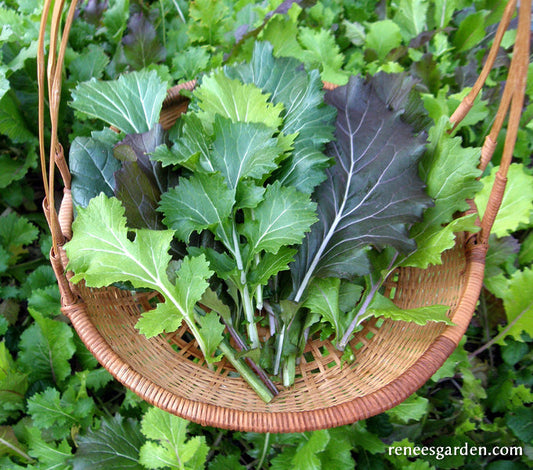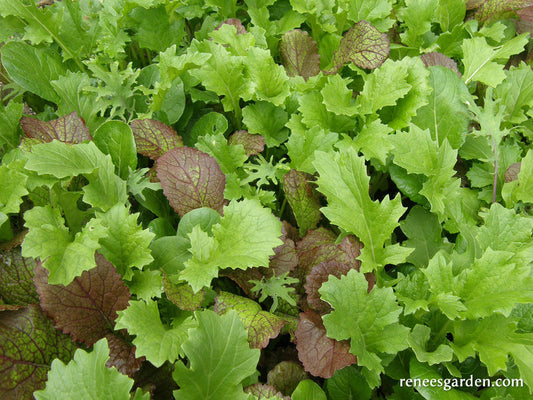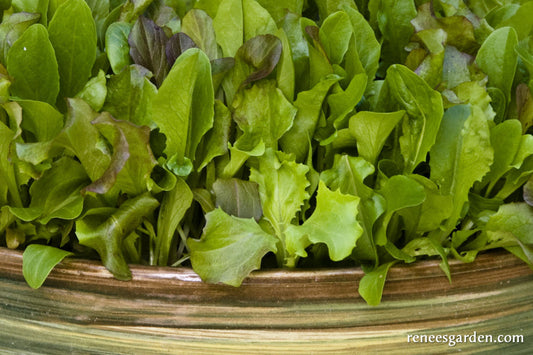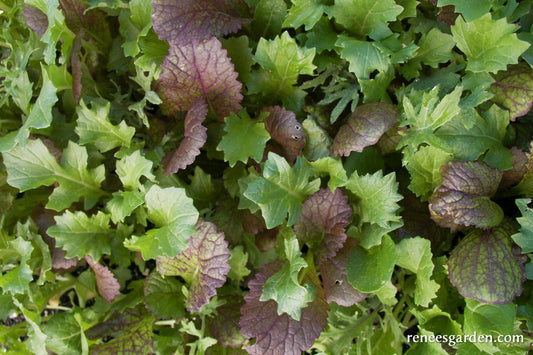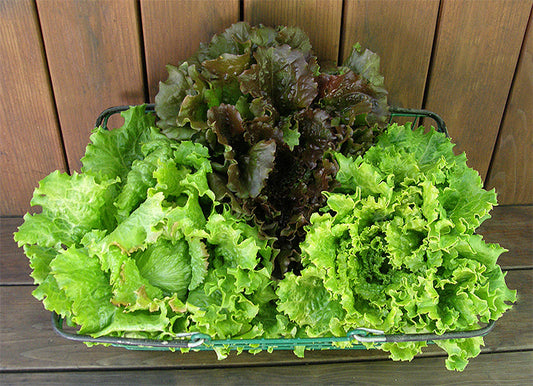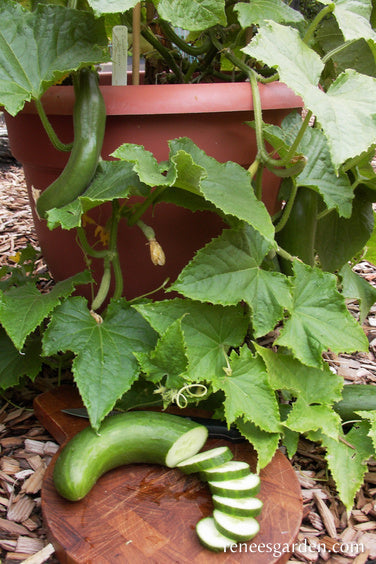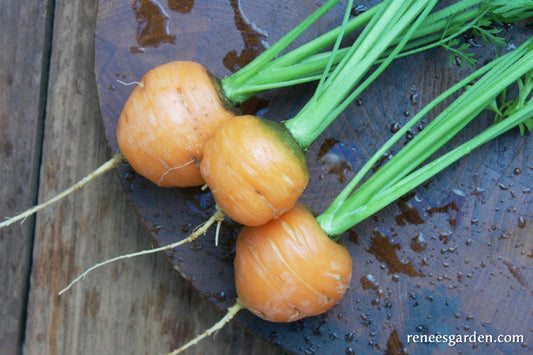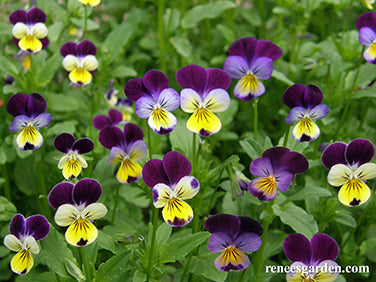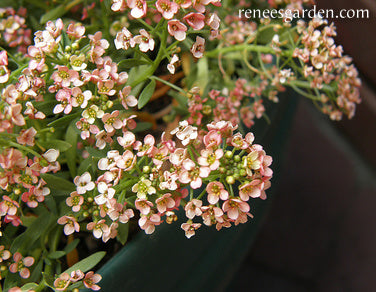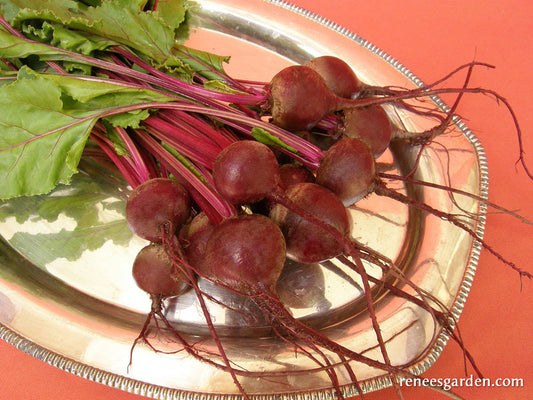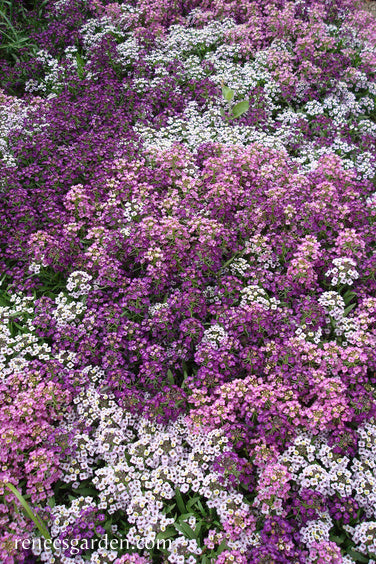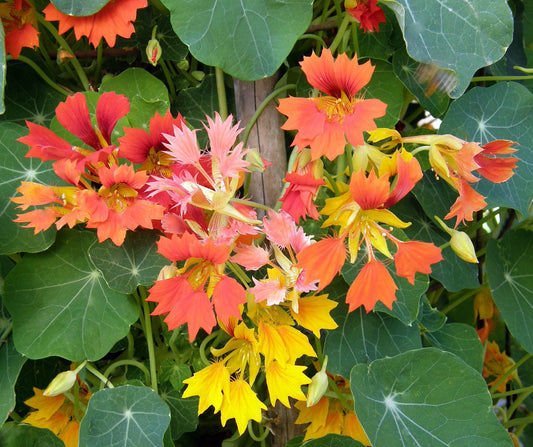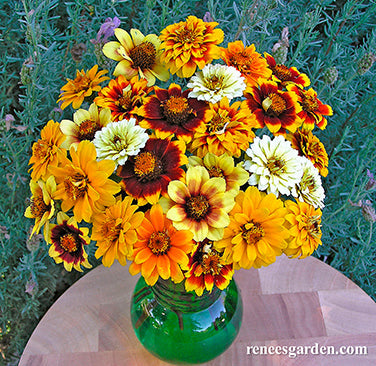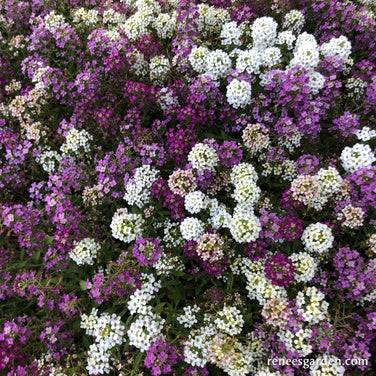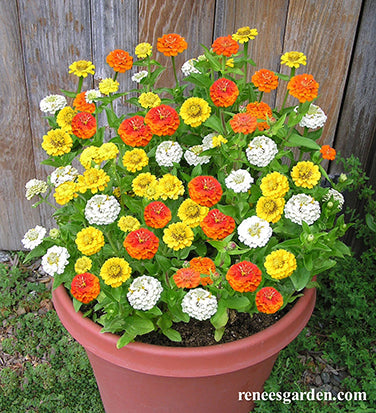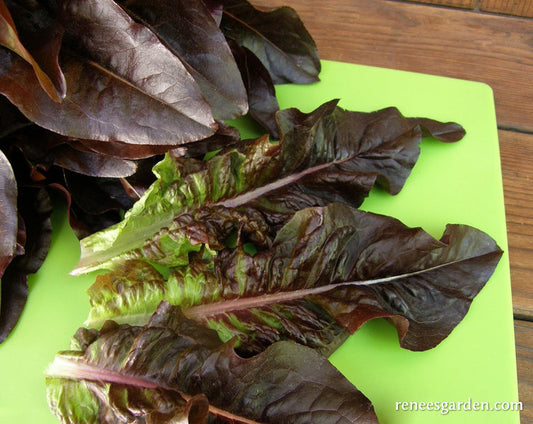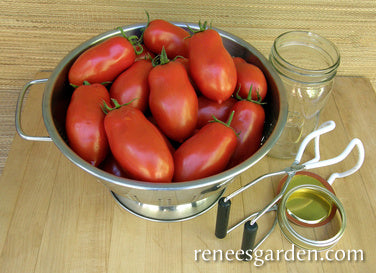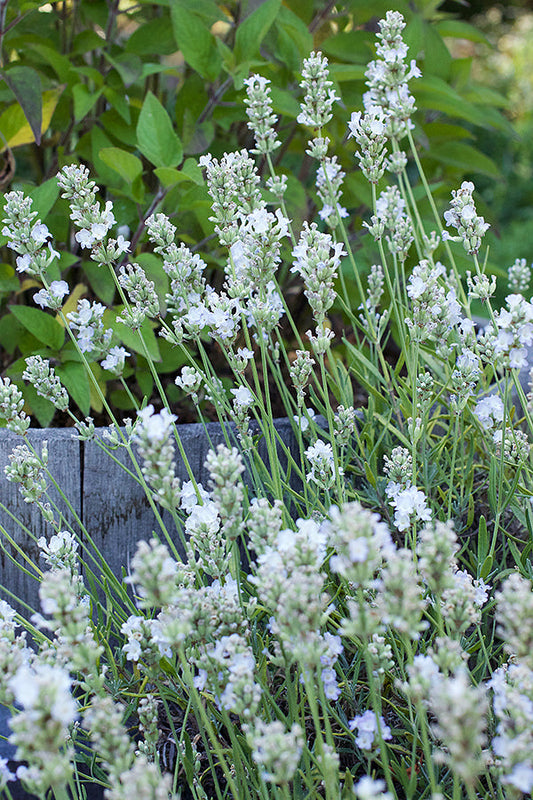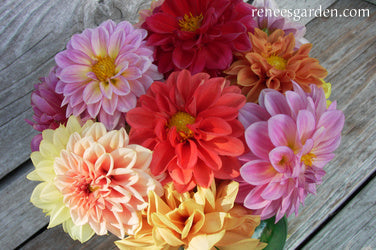Container Friendly
Space-Saving Varieties are Our Specialty
Grow a cheerful profusion of flowers and savory herbs in containers of all shapes and sizes on your patio, small deck, or rooftop.
-
Heirloom Greens Cut & Come Again Mustards
START SEEDS OUTDOORS
In cool early spring weather, sow seeds in finely worked soil in full sun. Shake seeds from the palm of your hand, broadcasting them about 1/2 inch apart over the entire seedbed or in wide rows, and cover lightly and evenly with 1/4 inch of fine soil. Firm soil gently and water with a fine spray. Keep seedbed evenly moist. Make small successive sowings until summer weather turns hot for a constant supply. Plant again in late summer for fall harvesting.
GROWING NOTES
This mix will thrive in mild weather with consistent moisture. To extend the sowing season into hot weather, sow in light shade or erect a canopy of loosely woven shade cloth over the bed. Birds are often attracted to tender young seedlings, so protect them if necessary.
HARVEST AND USE
To harvest by the “cut and come again” method, wait until plants are 4 to 6 inches tall. Cut as much as you need, using scissors to shear off a patch of leaves about 1 to 2 inches above the soil level. Water well and fertilize lightly and plants will regrow for several more cuttings. Sauté leaves quickly in olive oil with a little chopped garlic or steam and finish with a splash of hot sauce or rice vinegar.
Regular price $4.89Sale price $4.89Unit price / per -
Pan-Pacific Greens Renee's Stirfry Mix
BEST TO START DIRECTLY OUTDOORS
In cool early spring weather, sow seeds in finely worked soil in full sun. Shake seeds from the palm of your hand, broadcasting them about a half inch apart over the entire seedbed or in wide rows, and cover lightly and evenly with 1/2 inch of fine soil. Firm soil gently and water in with a fine spray. Keep seedbed evenly moist. Make small successive sowings until summer weather turns really hot for a constant supply. Plant again in late summer for fall harvesting.
GROWING NOTES
Our crunchy stir-fry mix tastes best given consistent moisture and mild weather conditions. Marauding birds are often attracted to tender young seedlings, so protect them if necessary with netting or floating row covers. Sown in a big container, these mixed leafy greens will make an ornamental and edible “color bowl” to snip and stir-fry as needed.
HARVEST AND USE
To harvest by the “cut and come again” method, wait until plants are 6 to 7 inches tall. Cut as much as you need, using scissors to shear off a patch of leaves 1 to 2 inches above the soil level. Water well and fertilize lightly and plants will regrow for several more cuttings. Sizzle these crunchy, succulent Asian greens in a quick stir-fry, or pick them earlier at 3 to 4 inches for tender young additions to colorful salads.
Regular price $3.39Sale price $3.39Unit price / per -
Gourmet Mesclun Salad Asian Baby Leaf
START SEEDS OUTDOORS
In cool early spring weather, sow seeds in finely worked soil in full sun. Shake seeds from the palm of your hand, broadcasting them about 1/2 inch apart over the entire seedbed or in wide rows, and cover lightly and evenly with 1/4 inch of fine soil. Firm soil gently and water with a fine spray.Keep seedbed evenly moist. Make small successive sowings until summer weather turns hot for a constant supply. Plant again in late summer for fall harvesting.
GROWING NOTES
This mix will thrive in mild weather with consistent moisture. To extend the sowing season into hot weather, sow in light shade or erect a canopy of loosely woven shade cloth over the bed. Birds are often attracted to tender young seedlings, so protect them if necessary.
HARVEST AND USE
To harvest by the “cut and come again” method, wait until plants are 4 to 6 inches tall. Cut as much as you need, using scissors to shear off a patch of leaves about 1 to 2 inches above the soil level. Water well and fertilize lightly and plants will regrow for several more cuttings. Dress with a simple vinaigrette to enjoy the sweet flavor and juicy texture of these delicate young leaves at their best. For this Asian mix, try using rice vinegar and a touch of soy sauce and garlic in your vinaigrette.
Regular price $3.39Sale price $3.39Unit price / per -
Baby Mesclun Lettuces Cut and Come Again
START SEEDS OUTDOORS
In early spring, sow seeds in finely worked soil in full sun. Shake seeds from the palm of your hand, broadcasting them about a half inch apart over the entire seedbed or in wide rows, and cover lightly and evenly with 1/4 inch of fine soil. Firm soil gently and water in with a fine spray. Keep seedbed evenly moist. Make small successive sowings until summer weather turns hot for a constant supply. Plant again in late summer for ample fall harvesting.
GROWING NOTES
This mesclun mix thrives in mild weather with consistent moisture. To extend the sowing season into hot weather, sow in light shade or erect a canopy of loosely woven shade cloth over the seed bed. Birds are often attracted to tender young seedlings so protect them if necessary.
HARVEST AND USE
Begin harvesting by the “cut and come again” method when plants are 4 or 5 inches tall. Cut as much lettuce as you need, using scissors to shear off a patch of leaves 1 to 2 inches above the soil level. Water well and fertilize lightly and plants will regrow for several more cuttings. Dress with a simple vinaigrette to enjoy the sweet flavor and juicy texture of these delicate young leaves at their best.
Regular price $3.39Sale price $3.39Unit price / per -
Signature Salads California Spicy Greens
START SEEDS OUTDOORS
In cool early spring weather, sow seeds in finely worked soil in full sun. Shake seeds from the palm of your hand, broadcasting them about 1/2 to 1 inch apart over the entire seedbed or in wide rows, and cover lightly and evenly with 1/4inch of fine soil. Firm soil gently and water in with a fine spray. Keep seedbed evenly moist. Make small successive sowings until summer weather turns hot for a constant supply. Plant again in late summer for fall harvesting.
GROWING NOTES
These zesty flavored salad greens taste best given consistent moisture and mild weather. To extend the growing season into hot weather, sow in light shade or erect a canopy of loosely woven shade cloth over the bed and water regularly. Birds are often attracted to tender young seedlings, so protect them if necessary.
HARVEST AND USE
To harvest by the “cut and come again” method, wait until plants are 3 or 4 inches tall. Cut as much as you need, using scissors to shear off a patch of leaves 1 to 2 inches above the soil level. Water well and fertilize lightly and plants will regrow for several more cuttings. Mix these piquant baby greens with lettuces and fragrant herbs in proportions you prefer.
Regular price $3.39Sale price $3.39Unit price / per -
Heirloom Greens Quick Stirfry Blend
BEST TO START DIRECTLY OUTDOORS
In cool early spring weather, sow seeds in finely worked soil in full sun. Shake seeds from the palm of your hand, broadcasting them about a half inch apart over the entire seedbed or in wide rows, and cover lightly and evenly with 1/4 inch of fine soil. Firm soil gently and water in with a fine spray. Keep seedbed evenly moist. Make small successive sowings until summer weather turns really hot for a constant supply. Plant again in late summer for fall harvesting.
GROWING NOTES
Our crunchy stir-fry mix tastes best given consistent moisture and mild weather conditions. Marauding birds are often attracted to tender young seedlings, so protect them if necessary with netting or floating row covers. Sown in a big container, these mixed leafy greens will make an ornamental and edible “color bowl” to snip and stir-fry as needed.
HARVEST AND USE
To harvest by the “cut and come again” method, wait until plants are 6 to 7 inches tall. Cut as much as you need, using scissors to shear off a patch of leaves 1 to 2 inches above the soil level. Water well and fertilize lightly and plants will regrow for several more cuttings. Sizzle these crunchy, succulent Asian greens in a quick stir-fry, or pick them earlier at 3 to 4 inches for tender young additions to colorful salads.
Regular price $4.89Sale price $4.89Unit price / per -
Crunchy Lettuce Trio Blush Batavians
START SEEDS OUTDOORS
In cool, early spring weather, start seeds in finely worked soil in full sun. Sow seeds 1/4 inch deep and 1 inch apart in rows 6 to 8 inches apart or broadcast thinly in beds and cover lightly. Tend carefully and keep evenly moist. Gradually thin seedlings to stand 10 to 12 inches apart to allow heads room to mature. Make several sowings a few weeks apart until summer weather turns hot for a constantly maturing supply. Plant again in late summer for fall harvesting.
GROWING NOTES
Lettuce thrives best in cool conditions with consistent moisture. Weed, water and thin carefully for best quality heads. If birds are attracted to young seedlings, cover them with floating row covers or netting.
HARVEST AND USE
Savor earliest thinnings in spring salads. Then harvest by cutting entire mature heads or picking outside leaves after plants are well established. To extend planting into hotter weather, sow new seeds in containers in light shade. Transplant seedlings into the garden, shading for a few days and harvest heads while still young. Tasty French Batavian lettuces form heavy rosettes of big crunchy leaves that tolerate both hot and cold weather well. Enjoy them with any kind of dressing from a simple vinaigrette to a rich, creamy Gorgonzola. Their crispy texture is also perfect in sandwiches or tacos.
Regular price $3.39Sale price $3.39Unit price / per -
Container Eggplant Little Prince
BEST TO START INDOORS
In early spring, start indoors about six to eight weeks before night temperatures reach 55° (13°C). Sow seeds 1/4 inch deep and 1 inch apart in containers of seed starting mix. Keep moist and warm, 80-85°F (27-29°C) and provide a strong light source until ready to plant outside. When seedlings are 2 inches tall, transplant into 4-inch pots. Maintain at 70-75°F (21-24°C). Feed with half-strength fertilizer every 2 weeks until weather is warm, then gradually acclimate seedlings to outdoor conditions.
Transplant In Pots: Plant 1 to a pot 12 inches across and deep, or plant several seedlings 8 inches apart in larger containers at least 16 to 18 inches across and deep.
In Garden Beds: Amend soil with compost or aged manure, then plant in full sun 2 feet apart.
GROWING NOTES
Transplant outdoors only when nights are securely above 55° (13°C). For containers, always use new, high quality potting mix. Plant only robust seedlings with well-developed roots and mulch them well. Feed regularly every few weeks throughout the season with good all-purpose fertilizer.
HARVEST AND USE
Pick often from productive plants when fruits size up glossy and firm-fleshed and before skins get dull. Enjoy these handy-sized eggplants halved or in thick slices sautéed with garlic and herbs or grilled to succulence on the barbeque.
Regular price $3.39Sale price $3.39Unit price / per -
Specialty Eggplants Italian Trio
BEST TO START INDOORS
In early spring, start indoors about 2 months before outdoor night temperatures are reliably in the 50 (10°C) range. Sow seeds 1/4 inch deep and 1 inch apart in a container of seed starting mix. Keep moist and warm and provide a strong light source until seedlings are ready to plant outside. When seedlings are 2 inches tall, transplant into deeper individual containers. Maintain at 70 to 75° (21-24°C). Feed with half-strength fertilizer every 2 weeks until weather is warm enough to gradually acclimate seedlings to outdoor conditions. Transplant 2 feet apart into rich soil in full sun.
GROWING NOTES
Don’t transplant these heat-lovers outdoors until night temperatures stay securely above 55° (13°C). Prepare soil well with aged manure or compost. Plant only robust seedlings with well-developed roots and mulch well. Fertilize plants regularly throughout the season.
HARVEST AND USE
Pick when fruits have sized up and are firm fleshed and glossy. Slice 1/2 inch thick, brush with olive oil and broil until tender. Then layer with a rich tomato sauce, fresh herbs and several cheeses to make Eggplant Parmesan. Bake whole in a hot oven, then scoop out flesh and mash with garlic, olive oil, lemon juice and chopped parsley for a savory dip to serve on toasted pita bread.
Regular price $3.69Sale price $3.69Unit price / per -
Container Cucumber Bush Slicer
START SEEDS OUTDOORS
Plant heat loving cucumbers only when spring weather is warmed and night temperatures are consistently above 55°F (13°C). Amend soil well with aged manure or compost. Sow seeds 1 inch deep and 4 inches apart in slightly mounded hills that are 3 feet apart, sowing 4 or 5 seeds in each hill. Thin to the 3 strongest seedlings in each hill so plants have room to grow and mature.
FOR CONTAINERS
Sow seed directly into containers 4 inches from edges. When plants are 3 to 4 inches tall, thin carefully to strongest seedlings. Final spacing should be one plant per pot 12 inches deep and 12 inches across or 2 plants in a larger container at least 18 inches across. For larger planters, grow plants at final spacing of 8 to10 inches apart.
GROWING NOTES
Protect seedlings from marauding birds with plastic berry baskets, removing before plants get crowded. Feed every other week. A good mulch will aid shallow rooted cucumber plants, which require ample and consistent moisture in hot dry weather. Avoid overly wet or dry periods for good quality fruit. In hot dry weather, check and water plants in containers daily.
HARVEST AND USE
Keep all mature cucumbers picked; fruits left on vines will signal the plant to stop producing. Cut rather than pull fruits from vines. Slice them up for refreshing snacks, salads and sandwiches. Eat within a day or two of picking for best taste and quality.
Regular price $3.39Sale price $3.39Unit price / per -
Container Chard Pot of Gold
EASIEST TO START OUTDOORS
For container sowing, use pots at least 12 inches in diameter and 12 inches deep and start with fresh potting mix. Plant seed in spring, after danger of frost is over, and/or again in mid-summer for fall harvests. Sow seed 1/2 inch deep and 1 inch apart in full sun. Keep evenly moist.
When seedlings are several inches tall, gradually thin to 8 inches apart in containers and use the delicious thinnings for early greens. Be sure to thin seedlings well so the large, vase-shaped plants have room to mature. If planting in garden beds, thin seedlings to stand 12 inches apart.
GROWING NOTES
Easy to grow chard can be grown year-round in mild winter areas. It prefers full sun, but will tolerate afternoon shade. Water regularly, checking containers daily in hot weather. Feed these fast-growing, productive plants weekly with a good high-nitrogen fertilizer. Watch for snails and slugs.
HARVEST AND USE
Begin harvesting when plants are well established and have 6 to 8 stalks. Both the crunchy succulent stalks and leaves make great eating. Break stems off at the base of the plant, always leaving at least 3 to 4 stalks to allow for regrowth. Chard is delicious sautéed, steamed, braised or stirfried. It pairs beautifully with the flavors of olive oil, garlic and lemon.
Regular price $3.39Sale price $3.39Unit price / per -
Round Baby Carrots Romeo
START SEEDS DIRECTLY OUTDOORS
In spring, once danger of hard frost is past, sow seeds in full sun in a container of fresh potting soil. To have enough soil surface and volume, containers should be at least 16 to 18 inches in diameter and 8 to 12 inches deep. Sow seeds carefully 1/2 inch apart and then cover very lightly.
Keep the seedbed evenly moist as carrots can be slow to germinate, emerging over 10 to 20 days. Germinating carrots need consistent moisture; a good trick is to cover the soil surface with floating row cover to help retain moisture during the germination period and water right through it. Take off the cover as soon as you see sprouts.
GROWING NOTES
Thin carrots several times so seedlings are 2 inches apart and have room to size up for harvest. Keep well watered for best growth and flavor. For a late season crop, sow again 3 months before first expected frost.when plants are young. Mulch well to conserve soil moisture and suppress weed growth.
HARVEST AND USE
Harvest at about 1 to 1 1/2 inches in diameter for best flavor. Steam whole, then toss with butter and fresh chopped dill, parsley or chives. Or toss with butter, salt lightly and add a little brown sugar or maple syrup.
Regular price $3.39Sale price $3.39Unit price / per -
Heirloom Edible Flowers Grandma's Johnny Jump Ups
PERENNIAL GROWN AS ANNUAL
Spring bloom
Can handle frostBEST TO PLANT DIRECTLY IN THE GARDEN
In Mild Winter Climates, sow seeds in fall and they will form deep roots over winter for a long spring bloom.
In Cold Winter Areas, sow in spring as soon as soil can be worked.
Violas can handle light frosts and bloom best when they get a good start in cool spring weather. Sow seeds 1 inch apart in well-drained soil in full sun. Cover 1/4 inch deep, firm soil and keep seed bed moist. Be patient; germination takes 14 to 21 days. When large enough to handle, thin or transplant seedlings to 4 to 5 inches apart.
To Start Early Indoors: Sow seeds 1 inch apart in seed starting mix, 8 to 10 weeks before last frost. Cover 1/4 inch deep, keep moist & provide a good light source until ready to plant outside when weather warms up. Transplant 4 to 5 inches apart when large enough to handle.
GROWING NOTES
These carefree plants are covered with cheerful flowers throughout spring & early summer. After initial flowering, cut plants back to several inches tall for another flush of bloom if the weather is not too hot. In milder climates, Johnny Jump Ups will self sow readily & come back each season. The dainty edible blossoms taste of wintergreen. They make great garnishes & are also perfect for candying.Regular price $3.39Sale price $3.39Unit price / per -
Honey-Scented Alyssum Summer Peaches
HARDY ANNUAL
Spring/summer bloom
Can handle frostEASIEST TO PLANT DIRECTLY IN THE GARDEN
Plant in early spring in well worked soil in a sunny spot. Sow 1/2 inch apart and barely cover. Keep evenly moist while awaiting germination. Seedlings will create a carpet of fine textured leaves, followed by a blanket of soft, airy flowers.
TO START EARLY INDOORS
Sow indoors 3 to 4 weeks before last frost in a large seed flat. Broadcast seeds 1/2 to 1 inch apart. To transplant, separate clusters of 4 to 5 seedlings and plant each cluster several inches apart.
GROWING NOTES
Given ordinary garden soil and even moisture, Summer Peaches grows easily and blooms profusely just 6 to 8 weeks from sowing. Plants stay compact and don’t get rangy. After the first flush of intense flowering is over, cut plants back halfway to re-bloom abundantly. In mild winter areas, sow Summer Peaches alyssum in the fall around bulbs, in containers or to cover bare areas. Plants overwinter to bloom all spring in a pretty carpet of pastel shades.Regular price $3.99Sale price $3.99Unit price / per -
Dutch Beets Baby Ball
START SEEDS OUTDOORS
In early spring when danger of hard frost is over, sow seeds in well-worked, fertile soil in full sun. Sow seeds 1 inch apart and 1/2 inch deep in rows 8 inches apart, or broadcast thinly for bed planting. Firm soil well over these irregularly shaped seeds to ensure good germination. If first sowing germinates unevenly, plant more seed in the rows as seedlings will catch up fast. Carefully thin when seedlings are large enough to handle to 3 to 4 inches apart so roots have room to grow and mature.
GROWING NOTES
For tender, best quality beets, sow seeds before midsummer heat and again in early fall at least 10 weeks before fall frosts. Keep soil evenly moist throughout the growing season. Be sure to thin beet seedlings carefully several times as they grow best when given enough room.
HARVEST AND USE
Harvest baby beets at 1 to 1 1/2 inches in diameter, or let some mature into full-sized beets. Briefly steam the tender-sweet tops for tasty greens. Freshly picked baby beets will cook very quickly; just steam, then peel and serve them with a little sweet butter and a sprinkle of chopped parsley or fresh dill leaf. Or try your own pickled baby beets!
Regular price $3.99Sale price $3.99Unit price / per -
Honey-Scented Alyssum Summer Romance
HARDY ANNUAL
Spring/summer bloom
Can handle frostEASIEST TO PLANT DIRECTLY IN THE GARDEN
Plant in early spring in well-worked soil in a sunny spot. Sow 1/2 inch apart and barely cover. Keep evenly moist while awaiting germination. Seedlings will create a carpet of fine textured leaves, followed by a blanket of soft, airy flowers.
TO START EARLY INDOORS
Sow indoors 3 to 4 weeks before last frost in a large seed flat. Broadcast seeds 1/2 to 1 inch apart. To transplant, separate clusters of 4 to 5 seedlings and plant each cluster 3 to 5 inches apart.
GROWING NOTES
Given ordinary garden soil and even moisture, alyssum grows easily and blooms profusely just 6 to 8 weeks from sowing. Plants stay compact and don't get rangy. After the first flush of intense flowering is over, cut plants back halfway to re-bloom abundantly. In mild winter areas, sow alyssum in the fall around bulbs, in containers or to cover bare areas. Plants overwinter to bloom all spring in a pretty carpet of pastel shades.
Regular price $3.69Sale price $3.69Unit price / per -
Heirloom Nasturtiums Climbing Phoenix
ANNUAL
Spring/Summer/Fall bloom
Frost tenderEASY TO START OUTDOORS
Sow seeds in spring once all danger of frost is over in full sun (or part shade in hot climates). Nasturtiums need no added fertilizer in most soils. Poke seeds into well-worked soil about 1 inch deep and 3 to 4 inches apart. Press soil firmly over the seeds and keep moist. When seedlings are large enough to handle, thin to stand 10 inches apart, or 6 to 8 inches apart if training seedlings up vertical supports.
TO START EARLY INDOORS
Sow 2 seeds each in individual 4-inch pots of well-drained seed starting mix 3 weeks before last expected frost date. Cover 1 inch deep. Provide a strong light source. When seedlings have several sets of leaves, pinch out the weaker seedling leaving 1 seedling per pot. When weather is evenly in the 50°F (10°C) range, gradually acclimate to outdoor conditions. Transplant as above in full sun.
GROWING NOTES
Climbing nasturtiums are easy to grow in any well-drained soil. You’ll need to train young plants onto their supports with loose ties, then they’ll climb easily and bloom non-stop. Do not let plants dry out during blooming season. If aphids become a problem, wash them off with a strong spray of water or spray with non-toxic Safer’s Soap solution. Phoenix’s bright confetti like blossoms are true summer beacons for hungry hummingbirds.
Regular price $3.99Sale price $3.99Unit price / per -
Heirloom Butterfly Zinnias Persian Carpet
ANNUAL
Summer/fall bloom
Frost tenderTO START DIRECTLY IN THE GARDEN
Sow seeds in well-worked soil in full sun when danger of frost is past and temperatures are above 50°F (10°C) both day and night. Space seeds 2 to 3 inches apart in rows 12 inches apart, cover about 1/2 inch deep and gently firm soil. Keep evenly moist while awaiting germination.
TO START EARLY INDOORS
Four weeks before last frost date, sow seeds 1/2 inch deep and 3 inches apart in containers of seed starting mix. Keep warm and moist and provide a strong light source. Feed with 1/2 strength fertilizer every 2 weeks. Just as soon as seedlings have several sets of true leaves, plant outdoors when temperatures stay above 50°F (10°C) at night.
THIN OR TRANSPLANT
Space seedlings 8 to 10 inches apart when large enough to handle to provide good air circulation and give plants room to mature.
GROWING NOTES
Zinnias grow readily in ordinary garden soil in full sun. Be sure to thin before seedlings get crowded; adequate spacing and regular even watering help keep zinnias productive and disease free. Grow colorful Persian Carpet in beds or borders, or combine with white alyssum, dwarf marigolds, petunias and salvia for season-long bloom in terracotta pots and color bowls.Regular price $2.99Sale price $2.99Unit price / per -
Honey-Scented Alyssum Gulf Winds
HARDY ANNUAL
Spring/summer bloom
Can handle frostEASIEST TO PLANT DIRECTLY IN THE GARDEN
Plant in early spring in well worked garden soil in a sunny spot. Sow seeds 1 to 2 inches apart and barely cover. Keep evenly moist while awaiting germination. Seedlings will grow into a carpet of fine textured leaves, followed by a blanket of soft flowers.
TO START EARLY INDOORS
Sow indoors 3 to 4 weeks before last frost in a large container. Broadcast seeds 1/2 to 1 inch apart. When seedlings are well established and the danger of frost is over, separate clusters of 4 to 5 seedlings and plant each cluster 3 to 5 inches apart in the garden.
GROWING NOTES
Given ordinary garden soil and even moisture, Gulf Winds grows and blooms quickly, but will stay compact. After the first flush of intense flowering is over, cut plants half way to re-bloom abundantly. In mild winter areas, sow again in the fall around bulbs, in containers, or to cover bare areas. Plants will grow and overwinter to bloom all spring in a pretty carpet of pastel shades.
Regular price $3.99Sale price $3.99Unit price / per -
Container Zinnias Pixie Sunshine
ANNUAL
Summer/fall bloom
Frost tenderEASIEST TO PLANT OUTDOORS
After danger of frost is past, sow seeds in full sun in well-worked soil. For container sowing, use fresh potting mix. Space seeds 2-3 inches apart, cover about 1/2 inch deep and gently firm soil. Keep soil evenly moist while awaiting germination. When seedlings are several inches tall, thin to final spacing: For Containers, 5 to 6 plants per 12 inch pot; In Garden Beds, space 8 inches apart.
TO START EARLY INDOORS
Several weeks before last frost date, sow seeds 1/2 inch deep and 2 inches apart in a container of seed starting mix. Keep warm and moist and provide a strong light source until ready to plant outdoors. Transplant carefully before plants get too large. Space plants carefully, so roots have room to grow and spread.
GROWING NOTES
For container planting, use pots at least 12 inches in diameter and 12 inches deep. These carefree 8 to 12 inch tall zinnias perform well in hot and sunny conditions. Water regularly and consistently. Support plants’ rapid growth by feeding with a well-balanced fertilizer every few weeks. Thin young seedlings to final spacing before too large. Remove spent flowers often to encourage new blooms.
Regular price $3.39Sale price $3.39Unit price / per -
Heirloom Cutting Lettuce Red Deer Tongue
START SEEDS OUTDOORS
In cool early spring weather, sow seeds in finely worked soil in full sun. Sow seeds about 1 inch apart over the entire seedbed or in wide rows, then cover lightly and evenly with 1/4 inch of fine soil. Firm soil gently and water with a fine spray. Keep seedbed evenly moist. Plant again as weather cools in late summer for fall salads.
GROWING NOTES
Thin seedlings to stand about 6 inches apart so they have room to grow and mature. Heirloom Red Deer Tongue grows and tastes best grown in mild spring or cooler fall weather with consistent moisture. To extend the sowing season slightly, sow in light shade or erect a canopy of loosely woven shade cloth over the bed. Birds are often attracted to tender young seedlings, so protect them with netting if necessary.
HARVEST AND USE
To harvest, wait until the plants form open, loose heads with leaves about 6 inches tall. Use scissors to cut leaves about 1 to 2 inches above the soil level. Water well and fertilize lightly and if weather is still cool, plants will re-grow tasty leaves for another cutting. These tasty, deep red leaves show off in the salad bowl and add interest to any sandwich. Hot summer temperatures turn this heirloom lettuce bitter; plant and harvest in cooler weather.
Regular price $3.39Sale price $3.39Unit price / per -
Container Roma Tomato Inca Jewels
STARTING SEEDLINGS
In early spring, start indoors about 6 to 8 weeks before outdoor night temperatures are reliably 50-55°F (10-13°C). Sow seeds 1/4 inch deep and 1 inch apart in a container of seed starting mix. Keep moist but not soggy, and very warm, 80°F (27°C). Provide a strong light source until seedlings are ready to plant outside. When seedlings are 2 inches tall, transplant into individual 4-inch pots. Maintain at 70°F (21°C). Feed with half-strength fertilizer every 2 weeks until ready to plant. When nights reach 55°F (13°C), gradually acclimate to outdoor conditions. Plant these vigorous, early bearing vines 3 feet apart into rich soil in full sun.
GROWING IN CONTAINERS
Transplant one seedling per container; minimum pot size should be 18 to 20 inches in diameter and 18 inches high. Use fresh potting mix to prevent soil-borne disease. Water regularly: containers may need water daily in hot weather. Fertilize every other week with a low nitrogen fertilizer for strong plants and good yields. Growing Notes Plant seedlings several inches deeper than they were in seed starter. Provide strong 3 ft. stakes or tall wire cages at planting time as plants get heavy with fruits and need support. Mulch to provide even moisture retention; don't overwater once fruit begins to ripen.Regular price $4.99Sale price $4.99Unit price / per -
Container Herbs White Ice Lavender
PERENNIAL
Late spring/early summer bloom
Frost hardy to zone 5 (zone 4 with protection)BEST TO PLANT INDOORS
In early spring, sow seeds about 1 inch apart in a container of seed starting mix, cover very lightly and keep at 60-70°F (16-21°C) in a spot with good air circulation. Keep evenly moist but not soggy. Seedlings emerge slowly and unevenly over 18 to 28 days. Provide a good light source.
When seedlings have several sets of leaves, transplant into 4 inch plastic pots. Provide consistent water, but let soil dry out on top between waterings. Feed every few weeks. Plant outside when plants are 2 to 3 inches tall after gradually acclimating to outdoors.
GROWING NOTES
Start these small seeds indoors so you can tend them carefully. When well established, plant seedlings out into pots filled with new potting mix with excellent drainage or in a well-drained, sunny garden spot with good air circulation. Plant one seedling per individual pot at least 8 inches wide and deep or space multiple plants 8 inches apart in larger, deeper containers. Feed monthly during the growing season.
Plants bloom the first season, but come into fullest flower by the second summer. Harvest stems of scented florets just as they start to open and air dry to use as aromatic sachets. At season’s end, shape plants by cutting off spent flower stalks down to top crown of leaves.
Regular price $4.99Sale price $4.99Unit price / per -
Border/Container Dahlias Watercolor Silks
PERENNIAL GROWN AS ANNUAL
Frost tender
Summer/Fall BloomBEST TO START EARLY INDOORS
Sow seeds 2 inches apart in containers of seed starting mix, 4 to 6 weeks before last spring frost. Cover 1/2 inch deep, keep moist and warm and provide a strong light source until ready to plant outdoors. When weather is warm and settled, acclimate seedlings gradually to outdoor conditions. Plant 8 inches apart.
TO START DIRECTLY OUTDOORS
Wait until weather is warm and settled and night temperatures are above 50°F (10°C). Sow groups of 2 to 3 seeds 1/2 inch deep and 8 inches apart in well-worked, fertile soil. Cover lightly and keep soil moist but not soggy while awaiting germination. When well-established, thin carefully, leaving single seedlings 8 inches apart, so plants have room to grow and bloom. Keep well-weeded and evenly watered.
GROWING NOTES
Amend soil with compost or aged manure before planting in full sun. Feed plants monthly. Remove faded flowers to prolong bloom. These dahlias will produce little underground tubers after their first season of bloom; select your favorite blossom colors when in bloom, then multiply those plants by digging up the tubers in late fall to replant the next spring.
To Grow In Containers: Space seedlings 4 to 6 inches apart in containers that are at least 16 inches across and 16 inches tall.
Regular price $3.39Sale price $3.39Unit price / per

